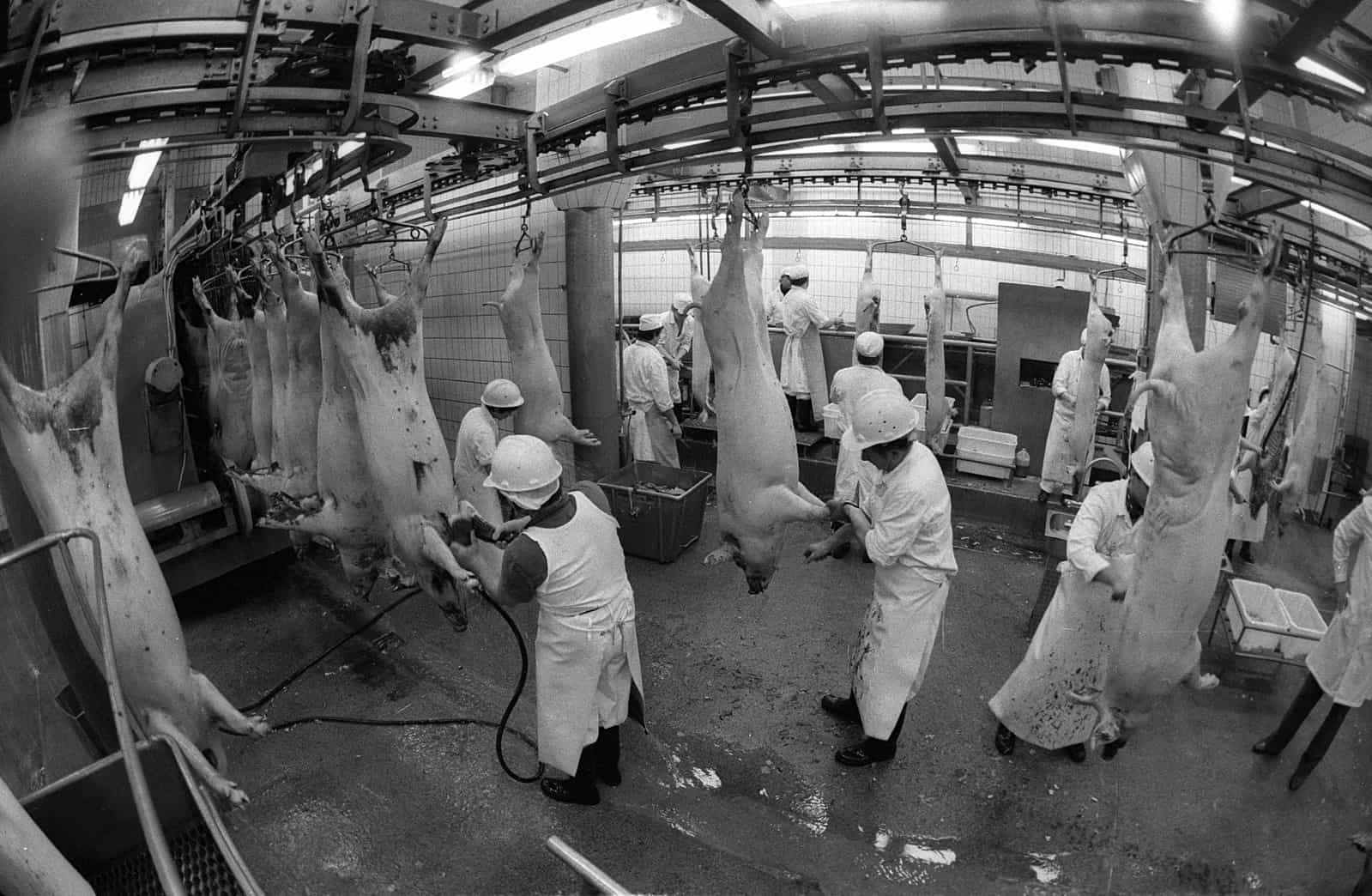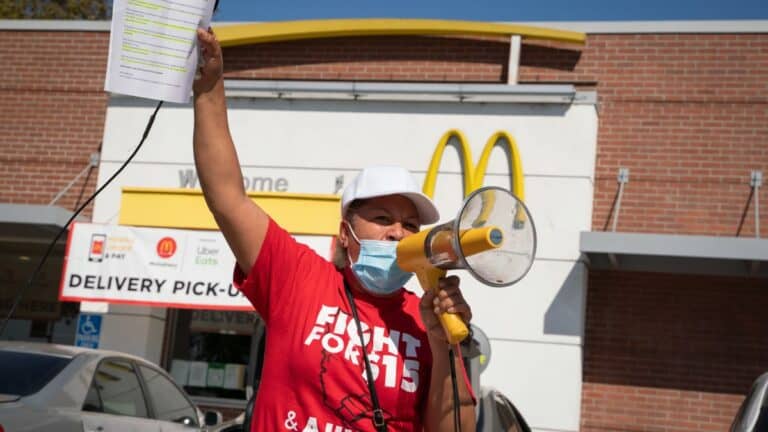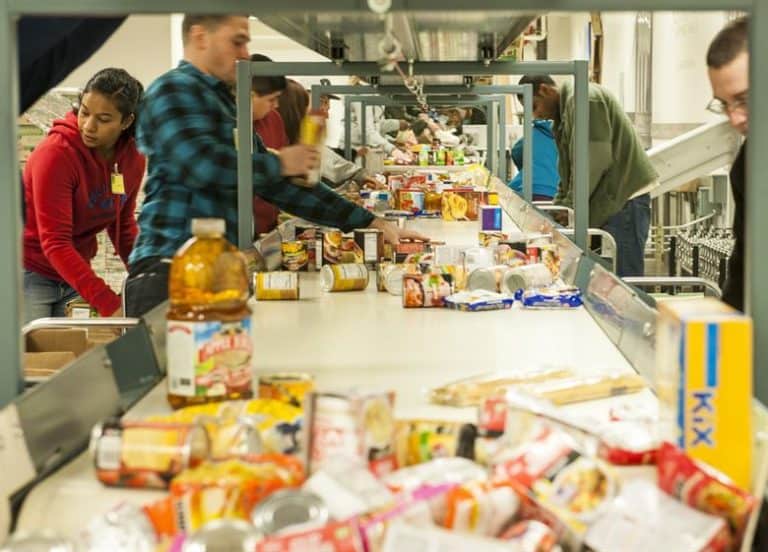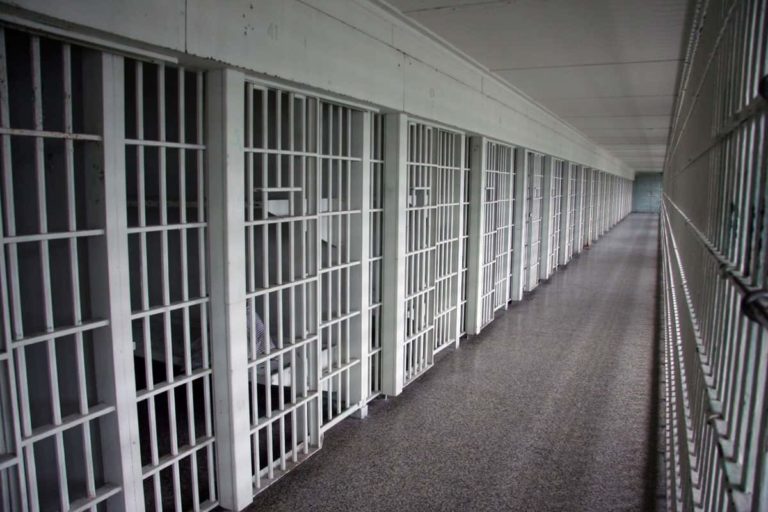Oscar Heanue is a student at Harvard Law School and a member of the Labor and Employment Lab.
Even as more Americans than ever report reducing their meat consumption, the US remains the highest per-capita consumer of meat worldwide. To meet this demand, nearly 9.5 billion animals are slaughtered in the US annually.
The burden of carrying out these killings falls almost exclusively on the employees of a relatively small number of high-volume, industrialized slaughterhouses, most of which are controlled by a handful of large corporations. Just 800 federally-inspected slaughterhouses are tasked with killing and processing the animals responsible for the bulk of the country’s 52 billion pounds of domestically-produced meat. For the employees of these slaughterhouses, the combination of increasing demand and industrial consolidation has led to high workloads and extreme line speeds. In an average cattle slaughterhouse, the “knocker” – the employee tasked with firing the bolt gun that kills or incapacitates each cow – sees around 2,500 animals per day, a rate of approximately one cow every twelve seconds.
The requirement to do violent, physically-demanding work at increasingly higher speeds has made animal slaughter one of the nation’s most dangerous occupations. In 2015, 5.4 percent of slaughterhouse workers experienced a job-related injury or illness. Many of these injuries were severe. Over a 31-week period from 2015-2017, there were 550 “serious” injuries reported in US slaughterhouses, including 270 incidents requiring the amputation of a body part. Those workers who do not suffer a serious acute injury are still at a disproportionately high risk of developing long-term conditions due to the repetitive and strenuous nature of their work. A 2015 NIH report, for example, found that in one Maryland plant, 76 percent of workers had abnormal nerve conditions in at least one hand. Additionally, slaughterhouse line workers are at elevated risk for various bacterial infections, which may require medical treatment.
For many slaughterhouse workers, however, physical injuries only scratch the surface of their suffering. A growing body of evidence has emerged surrounding the intense psychological toll that slaughterhouses have on the workers that allow them to operate. As one former slaughterhouse employee wrote for BBC, “I didn’t suffer physical injuries, but the place affected my mind… at night, my mind would taunt me with nightmares, replaying some of the horrors I’d witnessed.”
Industrialized slaughterhouses combine myriad factors that may be damaging to the psychological health and well-being of their workers. Slaughterhouse workers are subject to a dangerous and stressful working environment in which the threat of accident or injury looms large, yet constant productivity and focus is demanded. According to Human Rights Watch, a number of employees interviewed for an investigation of working conditions at meat and poultry plants recounted the emotional toll of verbal abuse and mistreatment by their employer. This verbal abuse often targets employees who are exhausted, injured, or are dealing with work-related pain.
Working in a stressful and potentially unsafe environment can, on its own, impact a worker’s mental health. However, as many researchers have noted, slaughterhouse work remains distinct from other dangerous industrial jobs in that the nature of the work itself is violent, and thus may inherently cause psychological distress or harm. Some slaughterhouse workers have discussed feeling the need to disassociate themselves from their work in order to suppress feelings of guilt when committing violent acts. Others have expressed increased feelings of aggression while working on the killing floor. These anecdotal reports from workers are borne out by academic research; slaughterhouse work has been linked to higher levels of aggression, violent dreams, anxiety, and hostility. Some researchers have categorized the psychological symptoms experienced by slaughterhouse employees as a form of trauma disorder, such as Post-Traumatic Stress Disorder (PTSD) or the more seldom-discussed Perpetration-Induced Traumatic Stress (PITS). As a whole, slaughterhouse workers experience significantly higher levels of serious psychological distress (SPD) than the general population.
Slaughterhouse workers who are struggling with their mental health are, as a result, likely to resort to negative coping mechanisms. Work at slaughterhouses has been associated with higher levels of substance abuse and addiction. Some experts have also argued that the psychological impact of work in slaughterhouses can lead workers to cause harm to others. A 2009 study from Michigan State University identified an uptick in violent crime associated with slaughterhouse employment. Researchers found that slaughterhouse employment was associated with an “increase in total arrest rates, arrests for violent crimes, arrests for rape, and arrests for other sex offenses in comparison with other industries.”
In sum, slaughterhouse workers frequently suffer physical injuries, infections, and illnesses as a result of performing their job; those who do not may still experience severe and lasting psychological harms. This bleak reality alone should be cause for concern, but the harm experienced by slaughterhouse workers is further compounded by the fact that these workers are typically underpaid and under-resourced, making it more difficult to get necessary care and treatment. Slaughterhouse workers earn a median wage of just $14.76 per hour, and disproportionately come from marginalized or underserved populations: 80.8 percent of frontline meatpacking workers are people of color, more than half were born outside of the United States, and over one-quarter come from households with limited English proficiency. Nearly half of all slaughterhouse workers live below 200 percent of the poverty line.
According to BLS estimates, conditions in slaughterhouses have improved in recent years – at least from a safety perspective. However, there is reason to be skeptical of these reported safety gains. For a variety of reasons, slaughterhouse injuries may go unreported. Many migrant workers in slaughterhouses are undocumented, and may fear retribution related to their immigration status if they report an injury. Employers may deliberately encourage workers not to report their injuries; for example, the Food Empowerment Project reported visiting a facility in which a sign was posted reading “0 Injuries Reported = End of Month BBQ.” Additionally, worker injuries may not be included in the meat and poultry industry totals, as many workers are employed through a third-party contractor. And, while data is collected on acute physical injuries, the lasting psychological pain and anguish felt by slaughterhouse workers may not be as easy to report.
There are solutions that could help reduce the suffering of slaughterhouse workers. Evidence suggests that reducing line speeds could cut down on injuries and disease transmission. Strengthening protections and resources for employees who are injured on the job to ensure that injuries are reported could also be crucial. Employers should also improve access to mental health counseling and resources for their workers.
While these changes would be a step in the right direction, the reality is that slaughterhouse work is, by nature, violent, dangerous, and taxing. Slaughterhouse workers are subject to physical stress and mental anguish that would be unacceptable in any other industry. As long as there is an industrialized meat industry, that may be unavoidable.
A better future for workers may mean moving away from industrialized animal slaughter and meat-based agriculture more generally. Some lawmakers have already proposed phasing out the largest animal agriculture operations in the near future. So long as the industrialized slaughter of animals remains a necessary evil, however, it is important that the health, safety, and psychological well-being of slaughterhouse employees is taken seriously by employers and regulators alike.










Daily News & Commentary
Start your day with our roundup of the latest labor developments. See all
September 26
Trump’s DOL seeks to roll back a rule granting FLSA protections to domestic care workers; the Second Circuit allows a claim of hostile work environment created by DEI trainings to proceed; and a GAO report finds alarming levels of sexual abuse in high school Junior Reserve Officers’ Training Corps programs.
September 25
Fenway workers allege retaliation; fired Washington Post columnist files grievance; Trump administration previews mass firings from government shutdown.
September 24
The Trump administration proposes an overhaul to the H-1B process conditioning entry to the United States on a $100,000 fee; Amazon sues the New York State Public Employment Relations Board over a state law that claims authority over private-sector labor disputes; and Mayor Karen Bass signs an agreement with labor unions that protects Los Angeles city workers from layoffs.
September 23
EEOC plans to close pending worker charges based solely on unintentional discrimination claims; NLRB holds that Starbucks violated federal labor law by firing baristas at a Madison, Wisconsin café.
September 22
Missouri lawmakers attack pro-worker ballot initiatives, shortcomings in California rideshare deal, some sexual misconduct claimants prefer arbitration.
September 21
USFS and California seek to improve firefighter safety, Massachusetts pay transparency law to take effect, and Trump adds new hurdles for H-1B visa applicants